How Lexus Plans To Take On BMW's 5-Series
But something happened after the IS F (an after-hours project until the engineers behind it convinced corporate), CT and LFA, and some would say it's about time: Lexus no longer wants to make cars just for people who don't like driving. The current Lexus slogan – at least, the one on the license plate surround of the GS 350 that Lexus gave us to drive – is "The Passionate Pursuit of Perfection." That was coined in 2000. In 2006, Toyota trademarked "The Passionate Pursuit of Potential."
The slogan was never used, but it's certain that Lexus feels the proof of that potential lives in this next-generation Lexus GS. We got a chance to drive a couple of pre-production models in California recently, and... Lexus might be right.
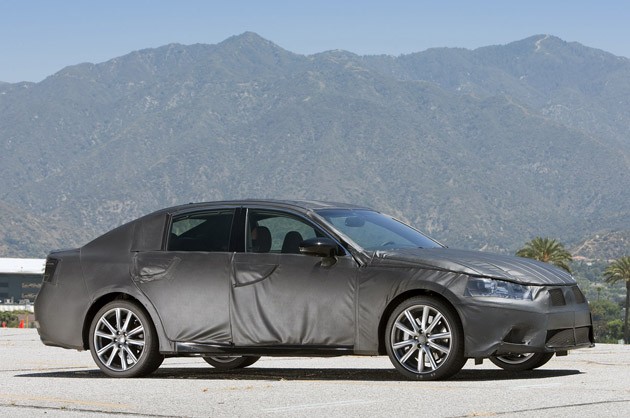
Said head engineer Koji Sato of the coming GS, "Joy of driving was the number one priority." Take all the time you need to soak that sentence up. This car is 'once more, with feeling,' gunning for the BMW 535 and Mercedes E350, and the message is that this sedan not only represents a jump forward for the model line, but also for the brand itself. "Lexus changed with the LFA," we were told, and those changes "are solidified in the new GS."
We've seen it at the Nürburgring, and even though the 2012 GS was under camo, the front end was obviously born with some LFA chromosomes. Yet the biggest – literally – difference is probably aft, where the fenders take a much more upright stance than the current model and the rear end loses its arc, going squared-off and vertical.
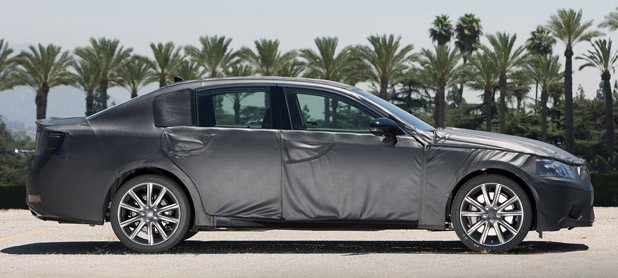
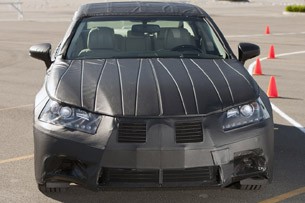
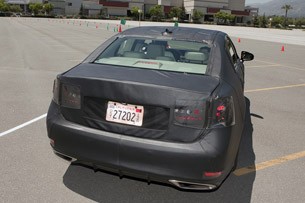
We're not sure if that's part of "the new generation of L-Finesse design language" that is more evident (even under camo) at the front of the car. The back is a more traditional cut, but it wasn't just a design consideration – changes underneath the skin necessitated and made the most of the new design. The beneficiary, at least as far as space is concerned, is the golfer in the family – packing 25-percent more trunk space, the new boot will hold four golf bags instead of two.
The word "traditional" might also apply to changes in the cabin, with a completely redesigned instrument panel. The current GS sports hectares of textured plastic atop the IP and around the beltline of the doors. It only gets fancy below the belt, where you'll find stitched leather wrapping the lower IP and door panels, and transmission tunnel.
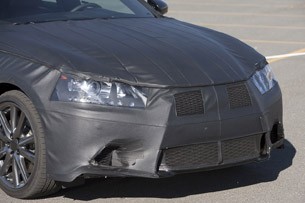
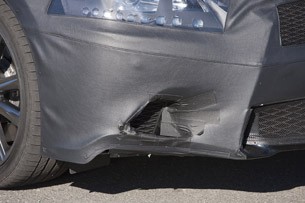
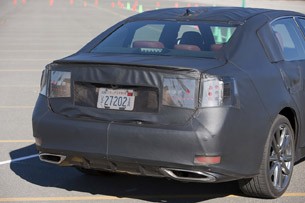
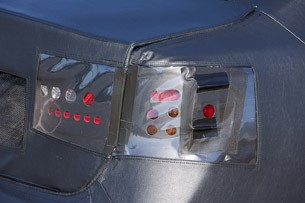
But you'll find stitched leather from top to bottom in the 2012 sedan. Truth be told, we didn't notice the plastics in the 2011 GS (BMW and Mercedes IPs are also synthetic city) until after we got in the 2012 and then got back in the 2011. The look and feel is so much nicer that it genuinely made us ask of the current car, "Have we really been okay with this all this time?"
And materials aren't the only story. Instead of a twin cockpit separated by the waterfall console, the IP runs unbroken across the car in one convex horizontal. The console touchscreen is no more, replaced by a larger screen in a recess at the top of the dash. It is controlled by a
knob on the center divider, meaning Lexus is eschewing the haptic feedback mouse-like controller found on the CT,
HS and
RX in favor of joining the COMAND, iDrive, MMI club
"remote touch controller," joining the rest of the clan in having the haptic feedback device.
The steering wheel is new, with a thicker rim. The shifter knob doesn't look like it was cribbed from a seventies Jaguar, and the kinks have been taken out of the gate. Passengers get seats with different contours; more shoulder, hip and foot space; and the repackaged driver's area is meant to provide a better field-of-vision.
That's all just the shell, and if the current GS is an oyster, Lexus is planning for the 2012 GS to be mother-of-pearl. The gem that its body and cabin play mother to, however, is not more gumption: the 2012 will come with a V6 that has just "a little more power" than the current car's 303 horsepower, and more frugality and efficiency.
Lexus will tell you that the pearl is the new suspension, and depending on how you look at it, they might have a point. Yet, while we'd admit that the revised linkages are a huge part of it, we think what's even more special is what the car will let you do with them.
The current GS is a capable-enough sedan. Or rather, we're pretty sure it's capable enough underneath the reactionary hausfrau gizmos that start screeching and turning on all the lights whenever things get fun. And deactivating the aids on the outgoing car never cured every ill, because then you still had to deal with the binary natures of the throttle and brake: you're either at full steam or full anchor.
Ladies and gentlemen, we're pleased to announce that those days are gone.
Well, unless you're on an autocross course. But we'll get to that in a moment.
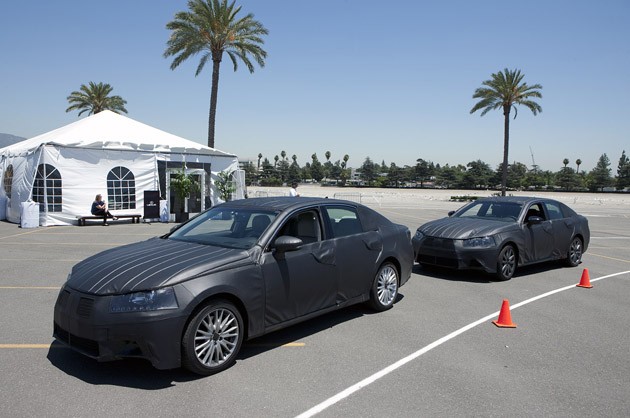
The 2012 GS sits on a new rear-wheel-drive platform that's solely for it and the IS, designed "specifically for fun and rewarding driving." It has the same wheelbase and overall width as the current platform, but the front track is wider by 1.6 inches, the rear track wider by two inches. The body is stiffer, using a different steel gauge in some areas or additional reinforcement, and employing increased spot and laser welding. Sato said that they used finite element analysis to study the effects of weld placement, but that the company left it to their Lexus Masters – in particular, to the seats of their pants – to decide what kind of assembly made the sedan most fun to drive.
The six-speed automatic transmission has been revised, it up- and downshifts more quickly and the driver has more control of shift timing. The responsiveness of the shift paddles has also been heightened, and when you're swapping cogs yourself, the engine will blip the throttle during downshifts in the sportier modes. To keep you mindful of your new capabilities, changes have been made to the V6's intake manifold and it wears a sound generator to provide more visceral acoustics for the engine and exhaust. In the current GS there's an exhaust valve to shut off sounds that's now gone. Throttle and brake pedals have also been blessed with much improved linear progression.
There were two models on hand to sample. Both had the 3.5-liter V6, but one was fitted with Lexus' new dynamic handling suspension (LDH) with variable gear ratio steering (VGRS) and dynamic rear steering (DRS). The VGRS is electrically operated – a motor moves the arms of the rearmost link of the rear suspension to angle the wheels. It does not work in Reverse, in case you were hoping for parallel parking help.
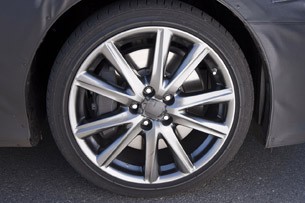
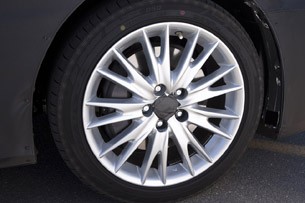
The LDH is new, on top of a suspension setup that has been completely retuned for the GS. That larger trunk we spoke of earlier is thanks to the rear suspension members being swung outward, making for more transverse room. Other details like the front shocks being canted back further, new upper aluminum arms and larger bushings have shed weight and improved steering feel.
The standard model gets 18-inch wheels with 235/45 R rubber all around. The LDH-equipped sedans get 235/40 R up front, 265/35 R in the back, and their brakes are sport versions: the rear calipers are aluminum instead of cast iron, and the front gets new aluminum calipers with high-friction pads clamping down on hybrid aluminum-and-steel rotors.
Both cars have four modes: Eco, Normal, Sport and Sport+. Turning the knob to Sport activates powertrain changes like throttle mapping and steering. Going all the way to Sport+ adds chassis enhancements like the rear-wheel steering, snappier settings for the adaptive damping and the transmission will hold gears longer.
All together, we were notified that the rework makes for a "level of agility probably never experienced in a Lexus before."

It began with the question most asked by anyone not used to driving a Lexus: "Is this running?" At idle, the GS remains all Lexus – whisper quiet.
Our first challenge was an autocross course. Although the 2012 GS has much kinder throttle and brake progression, the stab-and-squirt confines between the cones revealed that the bars for full steam and full anchor had simply been moved back. Hit the brakes hard, and that modulation turned grabby, hit the gas pedal and it felt like you ran nicely up to 60-percent throttle then jumped up to 90 percent.
Still, this fact was instantly apparent: As a sporting proposition, the 2012 GS is vastly superior to the car it will replace, even in Normal mode. Flipping to Sport and Sport+ yielded appreciable differences in reflexes and behavior. Yes, if you get way too hot into a corner, you're going to understeer your way to the outside cones, but as unlikely as this might seem, we learned something good about the car doing that: the nannies didn't rob us of exploring the car's limits – we were given time to correct the errors of our ways, and when you got it right you could enjoy the sustained whimpering of tires straddling the limit. The current GS 350 doesn't go for all that; driven like we drove the 2012, it would ask "What the @$%&! do you think you're doing?!," wave its Lexus Master wand and turn the car into a turtle.
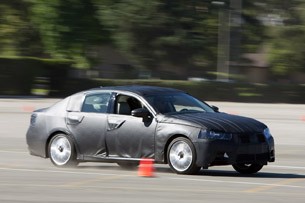
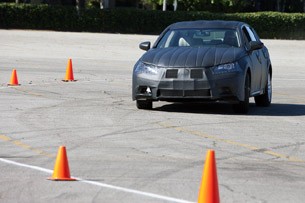
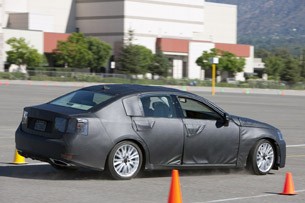
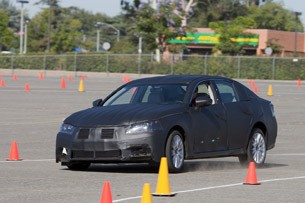
After three laps in, though, the brakes on both of the 2012 cars put up a stink about it.
Yet this was on an autocross course, possibly the last place you'd run a GS other than a World of Outlaws dirt oval.
In real life, up the sinuous rock-walled ribbon of Asuza Canyon, the Lexus began to reveal its potential. If sporty go is what you're after, then this GS has almost nothing in common with the current car other than its name. We did a run up and down the canyon in each of the 2012 cars, and even in the standard model, you can drive in ways that the current car simply will not allow. The LDH suspension then adds a quantifiable step beyond the standard car. On the first run, we wondered why the journo in the car in front of us kept braking for corners – we didn't need to. When we swapped cars, it only took one corner to find out why: diving into it as I did with the VGRS-equipped car, the back end slid right out. Not stepped out, slid out.
On the one hand, this was also rewarding – unless you turn off all the aids in the current car there might be a tiny chance you could get the rear out of line, but it would die of embarrassment before it would ever slide with its assistants activated. On the other hand, I had to temper the driving and find the new lower limits, and unless I channeled Ayrton Senna, I knew I'd never be able to keep the other journo in the VGRS-equipped car behind me. It was enough to have me saluting the Japanese engineer and his interpreter riding with me, neither of whom even reached for the armrests during my revelatory downhill run.
If anything, though, the massively improved driving experience presented a new niggle. The chaperones of the 2011 GS are too draconian to let you approach the car's limits. The 2012 LDH-equipped car handles so well and stays so hands-off that we lamented it not having more power and better reflexes so we could approach said limits. The suspension was more capable than the engine and transmission. We haven't felt that way about any Lexus other than the six-speed manual IS 250, a spirited little weakling of a car.
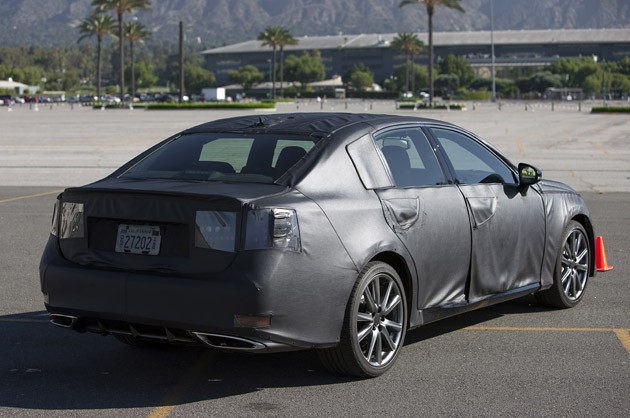
If this first blush is any indication, Lexus has done a very good job with the GS. It's now my even-more-favorite Lexus. Is it a 5 Series equal? Dynamically, probably not, but with the 5's move to more luxury – and with the Lexus being about 300 pounds lighter than a 535i with an auto 'box (estimated 3,638 pounds for the Lexus, 4,090 for the BMW) – it's actually reasonable to make a direct comparison now. And there's every chance it could have a better cabin. Compared to a Mercedes-Benz E 350? Yes on both counts, but that's a nearly pointless fight – no one thinks of the E 350 as a sports sedan, and it is more the brand argument Lexus is working to win against the Three-Pointed Star.
Nevertheless, with a little more power, lighter weight, better fuel economy, sharper reflexes and a gargantuan advance in handling (and babysitting) prowess, the 2012 Lexus GS already wins some of the most important and overdue arguments it will have with its toughest challengers: buyers. You'll get to weigh-in yourself in a couple of weeks, when the 2012 Lexus GS is unveiled at the Pebble Beach Concours de'Elegance in advance of a first-quarter launch next year.
Something happened after the IS F, CT and LFA: Lexus no longer wants to make cars for people who don't like driving.
Some might claim the Lexus IS has historically strayed furthest from the Lexus swarm, but the GS has always been a Lexus apart for this writer. Until recently it was only outdone by the original SC in terms of novel interpretations of the family design language, and it has been the least like a motorized cocoon. Others on the team disagree with me, contesting that the IS is more exciting, but – and this is just an opinion – even with the extra weight, I'd take a GS over an IS. It's been my favorite Lexus, but I'll admit the word "favorite" is a little bloodless here – the GS had no competition since there was no other Lexus I really wanted to drive.
But something happened after the IS F (an after-hours project until the engineers behind it convinced corporate), CT and LFA, and some would say it's about time: Lexus no longer wants to make cars just for people who don't like driving. The current Lexus slogan – at least, the one on the license plate surround of the GS 350 that Lexus gave us to drive – is "The Passionate Pursuit of Perfection." That was coined in 2000. In 2006, Toyota trademarked "The Passionate Pursuit of Potential."
The slogan was never used, but it's certain that Lexus feels the proof of that potential lives in this next-generation Lexus GS. We got a chance to drive a couple of pre-production models in California recently, and... Lexus might be right.

Said head engineer Koji Sato of the coming GS, "Joy of driving was the number one priority." Take all the time you need to soak that sentence up. This car is 'once more, with feeling,' gunning for the BMW 535 and Mercedes E350, and the message is that this sedan not only represents a jump forward for the model line, but also for the brand itself. "Lexus changed with the LFA," we were told, and those changes "are solidified in the new GS."
We've seen it at the Nürburgring, and even though the 2012 GS was under camo, the front end was obviously born with some LFA chromosomes. Yet the biggest – literally – difference is probably aft, where the fenders take a much more upright stance than the current model and the rear end loses its arc, going squared-off and vertical.



We're not sure if that's part of "the new generation of L-Finesse design language" that is more evident (even under camo) at the front of the car. The back is a more traditional cut, but it wasn't just a design consideration – changes underneath the skin necessitated and made the most of the new design. The beneficiary, at least as far as space is concerned, is the golfer in the family – packing 25-percent more trunk space, the new boot will hold four golf bags instead of two.
The word "traditional" might also apply to changes in the cabin, with a completely redesigned instrument panel. The current GS sports hectares of textured plastic atop the IP and around the beltline of the doors. It only gets fancy below the belt, where you'll find stitched leather wrapping the lower IP and door panels, and transmission tunnel.




But you'll find stitched leather from top to bottom in the 2012 sedan. Truth be told, we didn't notice the plastics in the 2011 GS (BMW and Mercedes IPs are also synthetic city) until after we got in the 2012 and then got back in the 2011. The look and feel is so much nicer that it genuinely made us ask of the current car, "Have we really been okay with this all this time?"
And materials aren't the only story. Instead of a twin cockpit separated by the waterfall console, the IP runs unbroken across the car in one convex horizontal. The console touchscreen is no more, replaced by a larger screen in a recess at the top of the dash. It is controlled by a
The steering wheel is new, with a thicker rim. The shifter knob doesn't look like it was cribbed from a seventies Jaguar, and the kinks have been taken out of the gate. Passengers get seats with different contours; more shoulder, hip and foot space; and the repackaged driver's area is meant to provide a better field-of-vision.
That's all just the shell, and if the current GS is an oyster, Lexus is planning for the 2012 GS to be mother-of-pearl. The gem that its body and cabin play mother to, however, is not more gumption: the 2012 will come with a V6 that has just "a little more power" than the current car's 303 horsepower, and more frugality and efficiency.
Lexus will tell you that the pearl is the new suspension, and depending on how you look at it, they might have a point. Yet, while we'd admit that the revised linkages are a huge part of it, we think what's even more special is what the car will let you do with them.
The current GS is a capable-enough sedan. Or rather, we're pretty sure it's capable enough underneath the reactionary hausfrau gizmos that start screeching and turning on all the lights whenever things get fun. And deactivating the aids on the outgoing car never cured every ill, because then you still had to deal with the binary natures of the throttle and brake: you're either at full steam or full anchor.
Ladies and gentlemen, we're pleased to announce that those days are gone.
Well, unless you're on an autocross course. But we'll get to that in a moment.

The 2012 GS sits on a new rear-wheel-drive platform that's solely for it and the IS, designed "specifically for fun and rewarding driving." It has the same wheelbase and overall width as the current platform, but the front track is wider by 1.6 inches, the rear track wider by two inches. The body is stiffer, using a different steel gauge in some areas or additional reinforcement, and employing increased spot and laser welding. Sato said that they used finite element analysis to study the effects of weld placement, but that the company left it to their Lexus Masters – in particular, to the seats of their pants – to decide what kind of assembly made the sedan most fun to drive.
The six-speed automatic transmission has been revised, it up- and downshifts more quickly and the driver has more control of shift timing. The responsiveness of the shift paddles has also been heightened, and when you're swapping cogs yourself, the engine will blip the throttle during downshifts in the sportier modes. To keep you mindful of your new capabilities, changes have been made to the V6's intake manifold and it wears a sound generator to provide more visceral acoustics for the engine and exhaust. In the current GS there's an exhaust valve to shut off sounds that's now gone. Throttle and brake pedals have also been blessed with much improved linear progression.
There were two models on hand to sample. Both had the 3.5-liter V6, but one was fitted with Lexus' new dynamic handling suspension (LDH) with variable gear ratio steering (VGRS) and dynamic rear steering (DRS). The VGRS is electrically operated – a motor moves the arms of the rearmost link of the rear suspension to angle the wheels. It does not work in Reverse, in case you were hoping for parallel parking help.


The LDH is new, on top of a suspension setup that has been completely retuned for the GS. That larger trunk we spoke of earlier is thanks to the rear suspension members being swung outward, making for more transverse room. Other details like the front shocks being canted back further, new upper aluminum arms and larger bushings have shed weight and improved steering feel.
The standard model gets 18-inch wheels with 235/45 R rubber all around. The LDH-equipped sedans get 235/40 R up front, 265/35 R in the back, and their brakes are sport versions: the rear calipers are aluminum instead of cast iron, and the front gets new aluminum calipers with high-friction pads clamping down on hybrid aluminum-and-steel rotors.
Both cars have four modes: Eco, Normal, Sport and Sport+. Turning the knob to Sport activates powertrain changes like throttle mapping and steering. Going all the way to Sport+ adds chassis enhancements like the rear-wheel steering, snappier settings for the adaptive damping and the transmission will hold gears longer.
All together, we were notified that the rework makes for a "level of agility probably never experienced in a Lexus before."

It began with the question most asked by anyone not used to driving a Lexus: "Is this running?" At idle, the GS remains all Lexus – whisper quiet.
Our first challenge was an autocross course. Although the 2012 GS has much kinder throttle and brake progression, the stab-and-squirt confines between the cones revealed that the bars for full steam and full anchor had simply been moved back. Hit the brakes hard, and that modulation turned grabby, hit the gas pedal and it felt like you ran nicely up to 60-percent throttle then jumped up to 90 percent.
Still, this fact was instantly apparent: As a sporting proposition, the 2012 GS is vastly superior to the car it will replace, even in Normal mode. Flipping to Sport and Sport+ yielded appreciable differences in reflexes and behavior. Yes, if you get way too hot into a corner, you're going to understeer your way to the outside cones, but as unlikely as this might seem, we learned something good about the car doing that: the nannies didn't rob us of exploring the car's limits – we were given time to correct the errors of our ways, and when you got it right you could enjoy the sustained whimpering of tires straddling the limit. The current GS 350 doesn't go for all that; driven like we drove the 2012, it would ask "What the @$%&! do you think you're doing?!," wave its Lexus Master wand and turn the car into a turtle.




After three laps in, though, the brakes on both of the 2012 cars put up a stink about it.
Yet this was on an autocross course, possibly the last place you'd run a GS other than a World of Outlaws dirt oval.
In real life, up the sinuous rock-walled ribbon of Asuza Canyon, the Lexus began to reveal its potential. If sporty go is what you're after, then this GS has almost nothing in common with the current car other than its name. We did a run up and down the canyon in each of the 2012 cars, and even in the standard model, you can drive in ways that the current car simply will not allow. The LDH suspension then adds a quantifiable step beyond the standard car. On the first run, we wondered why the journo in the car in front of us kept braking for corners – we didn't need to. When we swapped cars, it only took one corner to find out why: diving into it as I did with the VGRS-equipped car, the back end slid right out. Not stepped out, slid out.
On the one hand, this was also rewarding – unless you turn off all the aids in the current car there might be a tiny chance you could get the rear out of line, but it would die of embarrassment before it would ever slide with its assistants activated. On the other hand, I had to temper the driving and find the new lower limits, and unless I channeled Ayrton Senna, I knew I'd never be able to keep the other journo in the VGRS-equipped car behind me. It was enough to have me saluting the Japanese engineer and his interpreter riding with me, neither of whom even reached for the armrests during my revelatory downhill run.
If anything, though, the massively improved driving experience presented a new niggle. The chaperones of the 2011 GS are too draconian to let you approach the car's limits. The 2012 LDH-equipped car handles so well and stays so hands-off that we lamented it not having more power and better reflexes so we could approach said limits. The suspension was more capable than the engine and transmission. We haven't felt that way about any Lexus other than the six-speed manual IS 250, a spirited little weakling of a car.

If this first blush is any indication, Lexus has done a very good job with the GS. It's now my even-more-favorite Lexus. Is it a 5 Series equal? Dynamically, probably not, but with the 5's move to more luxury – and with the Lexus being about 300 pounds lighter than a 535i with an auto 'box (estimated 3,638 pounds for the Lexus, 4,090 for the BMW) – it's actually reasonable to make a direct comparison now. And there's every chance it could have a better cabin. Compared to a Mercedes-Benz E 350? Yes on both counts, but that's a nearly pointless fight – no one thinks of the E 350 as a sports sedan, and it is more the brand argument Lexus is working to win against the Three-Pointed Star.
Nevertheless, with a little more power, lighter weight, better fuel economy, sharper reflexes and a gargantuan advance in handling (and babysitting) prowess, the 2012 Lexus GS already wins some of the most important and overdue arguments it will have with its toughest challengers: buyers. You'll get to weigh-in yourself in a couple of weeks, when the 2012 Lexus GS is unveiled at the Pebble Beach Concours de'Elegance in advance of a first-quarter launch next year.
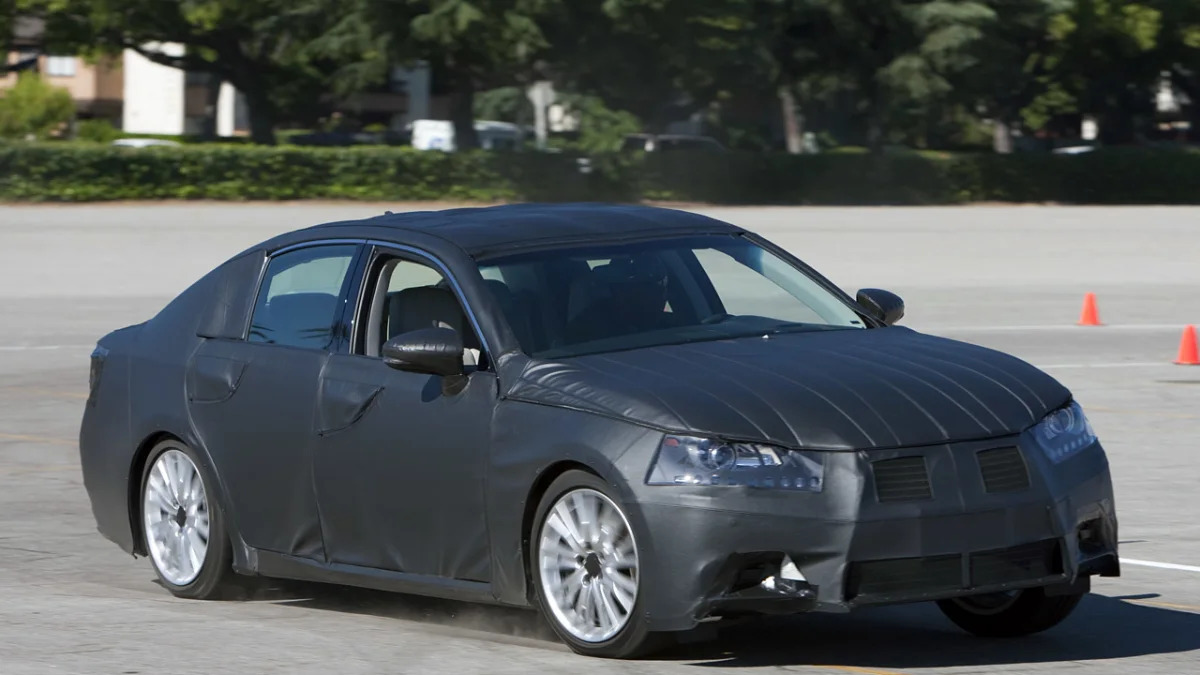
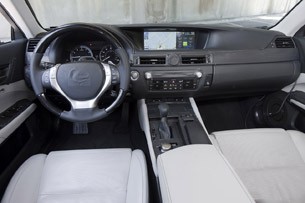
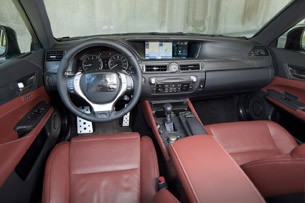
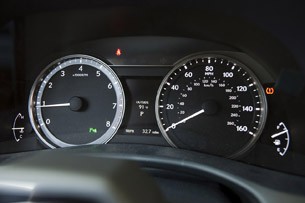
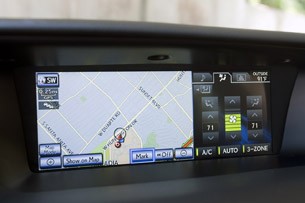









Sign in to post
Please sign in to leave a comment.
Continue